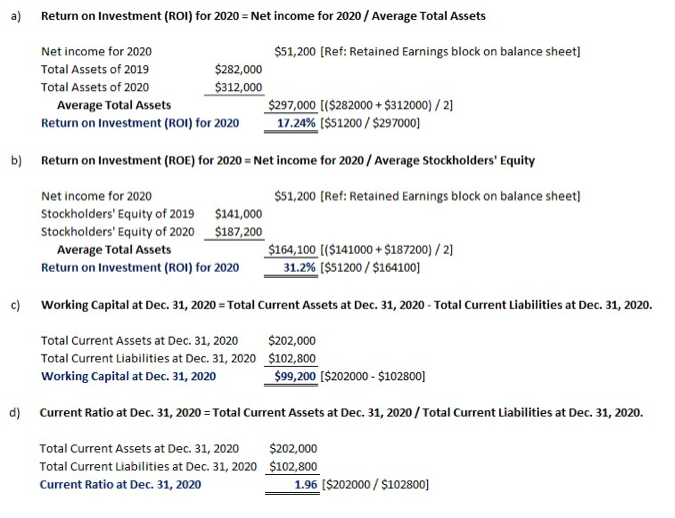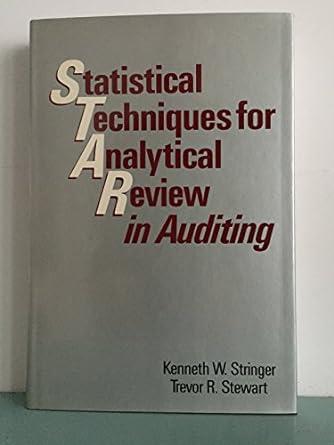Answered step by step
Verified Expert Solution
Question
1 Approved Answer
PLEASE COMPLETE e. - f. PLEASE COMPLETE e. - f. PLEASE COMPLETE e. - f. 2020 2019 $ 21,000 78,000 103,000 $ 202,000 50,000 125,000
PLEASE COMPLETE e. - f.

PLEASE COMPLETE e. - f.

PLEASE COMPLETE e. - f.
2020 2019 $ 21,000 78,000 103,000 $ 202,000 50,000 125,000 (65,000) $ 312,000 $ 21,000 72,000 99,000 $ 192,000 40,000 110,000 (60,000) $ 282,000 Assets Cash Accounts receivable Merchandise inventory Total current assets Land Plant and equipment Less: Accumulated depreciation Total assets Liabilities Short-term debt Accounts payable Other accrued liabilities Total current liabilities Long-term debt Total liabilities Stockholders' Equity Common stock, no par, 100,000 shares authorized 40,000 and 25,000 shares issued, respectively Retained earnings: Beginning balance Net income for the year Dividends for the year Ending balance Total stockholders' equity Total liabilities and stockholders' equity $ 18,000 64,800 20,000 $ 102,800 22,000 $ 124,800 $ 17,000 76,000 18,000 $ 111,000 30,000 $ 141,000 $ 74,000 $ 59,000 $ 82,000 51,200 (20,000) $ 113,200 $ 187,200 $ 312,000 $ 85,000 2,000 (5,000) $ 82,000 $ 141,000 $ 282,000 Required: a. Calculate ROI for 2020. (Do not round intermediate calculations. Round your final answer to 2 decimal places.) b. Calculate ROE for 2020. (Round your answer to 1 decimal place.) c. Calculate working capital at December 31, 2020. d. Calculate the current ratio at December 31, 2020. (Round your answer to 2 decimal places.) e. Calculate the acid-test ratio at December 31, 2020. (Round your answer to 2 decimal places.) f. Assume that on December 31, 2020, the treasurer of Hames decided to pay $15,000 of accounts payable. What impact, if any, this payment will have on the answers you calculated for parts a-d (increase, decrease, or no effect). g. Assume that instead of paying $15,000 of accounts payable on December 31, 2020. Hames collected $15,000 of accounts a) Return on Investment (ROI) for 2020 = Net income for 2020 / Average Total Assets $51,200 (Ref: Retained Earnings block on balance sheet] Net income for 2020 Total Assets of 2019 $282,000 Total Assets of 2020 $312,000 Average Total Assets Return on Investment (ROI) for 2020 $297,000 [($282000+ $312000)/2] 17.24% ($51200 / $297000) b) Return on Investment (ROE) for 2020 = Net income for 2020 / Average Stockholders' Equity $51,200 [Ref: Retained Earnings block on balance sheet] Net income for 2020 Stockholders' Equity of 2019 $141,000 Stockholders' Equity of 2020 $187,200 Average Total Assets Return on Investment (ROI) for 2020 $164,100 [($141000+ $187200)/2] 31.2% ($51200 / $164100) c) Working Capital at Dec 31, 2020 = Total Current Assets at Dec. 31, 2020 - Total Current Liabilities at Dec. 31, 2020. Total Current Assets at Dec. 31, 2020 Total Current Liabilities at Dec. 31, 2020 Working Capital at Dec 31, 2020 $202,000 $102,800 $99,200 [$202000 - $102800] Current Ratio at Dec. 31, 2020 = Total Current Assets at Dec. 31, 2020 / Total Current Liabilities at Dec. 31, 2020. Total Current Assets at Dec. 31, 2020 Total Current Liabilities at Dec. 31, 2020 Current Ratio at Dec. 31, 2020 $202,000 $102,800 1.96 ($202000 / $102800]Step by Step Solution
There are 3 Steps involved in it
Step: 1

Get Instant Access to Expert-Tailored Solutions
See step-by-step solutions with expert insights and AI powered tools for academic success
Step: 2

Step: 3

Ace Your Homework with AI
Get the answers you need in no time with our AI-driven, step-by-step assistance
Get Started


